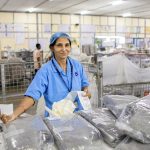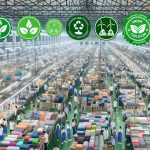Do you ever wonder what the future holds for sustainable denim manufacturing? Well, you’re in luck! In this article, we’ll explore the growing demand for eco-friendly denim.
We’ll also discuss the importance of collaboration and transparency in the supply chain.
Additionally, we’ll delve into the innovative technologies that are reducing water consumption.
Furthermore, we’ll examine the advancements in chemical-free dyeing processes.
Lastly, we’ll explore the use of organic and recycled materials.
Get ready to dive into the exciting world of sustainable denim!
Table of Contents
Growing Demand for Sustainable Denim
If you’re looking for sustainable denim, you’ll be pleased to know that the demand for environmentally-friendly jeans is on the rise. As more people become aware of the negative impact of the fashion industry on the environment, they’re seeking out alternatives that align with their values. This growing consumer awareness has fueled the demand for sustainable denim, pushing manufacturers to adopt more eco-friendly practices.
One of the key concepts driving the demand for sustainable denim is the circular economy. Unlike the traditional linear economy, which follows a take-make-waste model, the circular economy aims to keep resources in use for as long as possible. In the context of denim manufacturing, this means reusing and recycling materials to minimize waste and reduce the industry’s carbon footprint. Consumers are increasingly drawn to brands that embrace the circular economy and prioritize sustainability in their production processes.
Furthermore, consumer awareness has played a crucial role in driving the demand for sustainable denim. People are becoming more educated about the environmental and social consequences of fast fashion, prompting them to seek out alternatives that prioritize ethical and sustainable practices. By choosing to support brands that prioritize sustainability, consumers are sending a powerful message to the fashion industry and encouraging other companies to follow suit.
Innovative Technologies for Water Reduction
You can explore innovative technologies that reduce water usage in denim manufacturing. Here are four exciting advancements that are revolutionizing the industry:
-
Smart Textiles: By incorporating smart textile technology into denim manufacturing, water consumption can be significantly reduced. Smart textiles are designed with embedded sensors that can detect moisture levels in the fabric. This enables manufacturers to optimize the dyeing and finishing processes, reducing the need for excessive water usage.
-
Nanotechnology: Nanotechnology offers a promising solution for water reduction in denim manufacturing. By applying nanoscale coatings to denim fabrics, water repellency can be achieved without compromising breathability or comfort. This means that less water is required during the washing and finishing stages, resulting in substantial water savings.
-
Waterless Dyeing: Traditional denim dyeing methods require substantial amounts of water. However, innovative waterless dyeing technologies are now available. These technologies use compressed carbon dioxide or other alternative solvents to apply color to the fabric. This eliminates the need for large volumes of water, making the dyeing process more environmentally friendly.
-
Closed-loop Systems: Closed-loop systems are another innovative approach to water reduction in denim manufacturing. These systems capture and treat water used in various processes, allowing it to be reused. By implementing closed-loop systems, manufacturers can significantly minimize their water consumption and reduce their environmental impact.
With the adoption of these innovative technologies, the future of sustainable denim manufacturing looks increasingly promising. These advancements not only reduce water usage but also contribute to a more environmentally friendly and socially responsible industry.
Advancements in Chemical-Free Dyeing Processes
Continuing the discussion on reducing water usage in denim manufacturing, advancements in chemical-free dyeing processes are revolutionizing the industry. Chemical free dyeing alternatives and eco-friendly dyeing techniques are being developed to address the environmental impact of traditional dyeing methods. These new processes aim to eliminate the use of harmful chemicals, reduce water consumption, and minimize waste generation.
One promising chemical-free dyeing alternative is plant-based dyes. Natural dyes derived from plants, such as indigo, can be used to achieve different shades of blue, giving denim manufacturers a sustainable and environmentally friendly option. Additionally, some companies are exploring the use of enzymes and bacteria to create dye colors without the need for chemical additives. These eco-friendly dyeing techniques not only minimize the environmental impact but also improve the overall quality of the dyed fabric.
Another advancement in chemical-free dyeing processes is the use of waterless dyeing technologies. Instead of relying on large amounts of water to dissolve dyes and apply them to the fabric, these technologies use gas or supercritical carbon dioxide to dye the denim. This eliminates the need for water, reducing water consumption and minimizing wastewater discharge. Moreover, these waterless dyeing techniques offer better colorfastness and reduced color bleeding, resulting in higher quality and longer-lasting denim products.
Use of Organic and Recycled Materials
Organic and recycled materials play a crucial role in the future of sustainable denim manufacturing. By using these materials, manufacturers can reduce waste, minimize environmental impact, and create products that aren’t only fashionable but also eco-friendly.
Here are four reasons why the use of organic and recycled materials is important in sustainable denim manufacturing:
-
Reducing waste: By upcycling denim, manufacturers can repurpose old jeans and denim scraps, preventing them from ending up in landfills. This not only reduces waste but also conserves resources that would have been used to produce new materials.
-
Lowering environmental impact: Organic materials, such as organic cotton, are grown without the use of harmful pesticides and chemicals. By using organic materials, manufacturers can minimize the negative impact on the environment and promote healthier farming practices.
-
Promoting sustainability: The use of recycled materials, such as recycled polyester or plastic bottles, helps reduce the demand for new raw materials. This promotes a circular economy and reduces the need for extracting finite resources.
-
Eco-friendly washing techniques: The use of organic and recycled materials also aligns with eco-friendly washing techniques. These techniques minimize water usage, energy consumption, and the release of harmful chemicals into the environment, further enhancing the sustainability of denim manufacturing.
Collaboration and Transparency in the Supply Chain
The collaboration and transparency in the supply chain are crucial for the future of sustainable denim manufacturing. In order to achieve sustainable practices in the denim industry, collaboration initiatives and traceability solutions are essential.
Collaboration among different stakeholders, including brands, manufacturers, and suppliers, is necessary to address the complex challenges of sustainability. By working together, these stakeholders can share knowledge, resources, and best practices to develop innovative solutions. Collaboration initiatives can include partnerships between brands and manufacturers to implement sustainable production processes, as well as collaborations between manufacturers and suppliers to ensure the sourcing of sustainable materials.
Furthermore, transparency in the supply chain is vital for sustainable denim manufacturing. It allows brands and consumers to have visibility into the entire production process, from raw material sourcing to the final product. By implementing traceability solutions, such as blockchain technology or RFID tagging, brands can track and verify the origin and sustainability credentials of their denim products. This transparency enables brands to make informed decisions about their supply chain, ensuring that ethical and sustainable practices are being followed.
Challenges and Opportunities for Sustainable Denim Manufacturing
Now let’s talk about the challenges and opportunities that lie ahead in sustainable denim manufacturing.
One key challenge is reducing the environmental impact of denim production, considering the heavy use of water, energy, and chemicals. However, this also presents an opportunity for innovation, as companies are increasingly investing in new technologies and processes to minimize their ecological footprint.
Environmental Impact Reduction
To reduce the environmental impact of sustainable denim manufacturing, you can implement several strategies.
Here are four ways to address the challenges and opportunities for reducing environmental impact in the denim industry:
-
Adopt eco-friendly dyeing techniques: Utilize natural dyes or low-impact dyes that minimize chemical usage and water waste.
-
Embrace organic cotton: Choose organic cotton, which is grown without pesticides and reduces water consumption.
-
Implement water-saving methods: Opt for technologies like laser fading and ozone washing to minimize water usage and chemical discharge.
-
Promote recycling and upcycling: Encourage the reuse of denim scraps and old jeans to create new garments or accessories.
Innovations in Denim Production
To continue reducing the environmental impact of sustainable denim manufacturing, you can explore the challenges and opportunities for innovation in denim production.
One of the most promising innovations in denim production is laser distressing. This technique uses lasers to create the distressed look on denim, replacing the traditional method of using harmful chemicals and sandblasting. Laser distressing not only reduces the use of harmful substances but also improves worker safety.
Another innovation is digital printing, which allows for more precise and efficient application of designs and patterns onto denim fabric. This eliminates the need for excessive water and chemical usage in traditional printing methods.
Frequently Asked Questions
How Does Sustainable Denim Manufacturing Contribute to Reducing the Fashion Industry’s Environmental Impact?
Reducing water consumption and using eco-friendly dyeing techniques in sustainable denim manufacturing help to minimize the fashion industry’s environmental impact. By adopting these practices, you contribute to a greener and more sustainable future.
What Are Some of the Major Challenges Faced by Manufacturers in Implementing Sustainable Denim Manufacturing Practices?
Challenges in implementing sustainable denim manufacturing practices include sourcing eco-friendly materials, reducing water and energy consumption, and ensuring worker safety. Strategies like adopting new technologies and collaborating with suppliers can help overcome these challenges.
How Can Consumers Differentiate Between Genuinely Sustainable Denim Products and Those That Merely Claim to Be Eco-Friendly?
To differentiate between genuinely sustainable denim products and those that claim to be eco-friendly, consumer awareness is key. You can detect greenwashing by examining certifications, researching brands’ sustainability commitments, and supporting transparent and accountable companies.
Are There Any Governmental Regulations or Policies in Place to Promote and Support Sustainable Denim Manufacturing?
Governmental regulations and policies play a crucial role in promoting and supporting sustainable denim manufacturing. They help reduce the fashion industry’s environmental footprint by ensuring that denim products meet certain eco-friendly standards.
How Do Collaborations and Transparency in the Supply Chain Help to Ensure the Sustainability of Denim Manufacturing Processes?
Collaborative initiatives and traceability in the supply chain help ensure the sustainability of denim manufacturing processes. By working together and being transparent, companies can identify areas for improvement and implement eco-friendly practices for a greener future.
- Me+Em Teddy Bouclé: The Ultimate Cozy Outerwear Piece - July 3, 2025
- Me+Em Cropped Bouclé Jacket: A Chic and Modern Wardrobe Staple - July 3, 2025
- Me+Em Bouclé: A Review of the Jacket, Skirt, and Dress Collection - July 3, 2025




